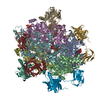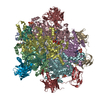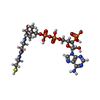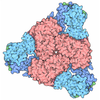[English] 日本語
 Yorodumi
Yorodumi- EMDB-17778: Engineered glycolyl-CoA carboxylase (G20R variant) with bound CoA -
+ Open data
Open data
- Basic information
Basic information
| Entry |  | ||||||||||||
|---|---|---|---|---|---|---|---|---|---|---|---|---|---|
| Title | Engineered glycolyl-CoA carboxylase (G20R variant) with bound CoA | ||||||||||||
 Map data Map data | main map | ||||||||||||
 Sample Sample |
| ||||||||||||
 Keywords Keywords | glycolyl-CoA carboxylase /  LIGASE LIGASE | ||||||||||||
| Function / homology |  Function and homology information Function and homology information propionyl-CoA carboxylase / propionyl-CoA carboxylase /  propionyl-CoA carboxylase activity / lipid catabolic process / propionyl-CoA carboxylase activity / lipid catabolic process /  ATP binding / ATP binding /  metal ion binding metal ion bindingSimilarity search - Function | ||||||||||||
| Biological species |   Methylorubrum extorquens AM1 (bacteria) Methylorubrum extorquens AM1 (bacteria) | ||||||||||||
| Method |  single particle reconstruction / single particle reconstruction /  cryo EM / Resolution: 2.31 Å cryo EM / Resolution: 2.31 Å | ||||||||||||
 Authors Authors | Zarzycki J / Marchal DG / Schulz L / Prinz S / Erb TJ | ||||||||||||
| Funding support | European Union,  Germany, 3 items Germany, 3 items
| ||||||||||||
 Citation Citation |  Journal: ACS Synth Biol / Year: 2023 Journal: ACS Synth Biol / Year: 2023Title: Machine Learning-Supported Enzyme Engineering toward Improved CO-Fixation of Glycolyl-CoA Carboxylase. Authors: Daniel G Marchal / Luca Schulz / Ingmar Schuster / Jelena Ivanovska / Nicole Paczia / Simone Prinz / Jan Zarzycki / Tobias J Erb /  Abstract: Glycolyl-CoA carboxylase (GCC) is a new-to-nature enzyme that catalyzes the key reaction in the tartronyl-CoA (TaCo) pathway, a synthetic photorespiration bypass that was recently designed to improve ...Glycolyl-CoA carboxylase (GCC) is a new-to-nature enzyme that catalyzes the key reaction in the tartronyl-CoA (TaCo) pathway, a synthetic photorespiration bypass that was recently designed to improve photosynthetic CO fixation. GCC was created from propionyl-CoA carboxylase (PCC) through five mutations. However, despite reaching activities of naturally evolved biotin-dependent carboxylases, the quintuple substitution variant GCC M5 still lags behind 4-fold in catalytic efficiency compared to its template PCC and suffers from futile ATP hydrolysis during CO fixation. To further improve upon GCC M5, we developed a machine learning-supported workflow that reduces screening efforts for identifying improved enzymes. Using this workflow, we present two novel GCC variants with 2-fold increased carboxylation rate and 60% reduced energy demand, respectively, which are able to address kinetic and thermodynamic limitations of the TaCo pathway. Our work highlights the potential of combining machine learning and directed evolution strategies to reduce screening efforts in enzyme engineering. | ||||||||||||
| History |
|
- Structure visualization
Structure visualization
| Supplemental images |
|---|
- Downloads & links
Downloads & links
-EMDB archive
| Map data |  emd_17778.map.gz emd_17778.map.gz | 246.5 MB |  EMDB map data format EMDB map data format | |
|---|---|---|---|---|
| Header (meta data) |  emd-17778-v30.xml emd-17778-v30.xml emd-17778.xml emd-17778.xml | 17.4 KB 17.4 KB | Display Display |  EMDB header EMDB header |
| FSC (resolution estimation) |  emd_17778_fsc.xml emd_17778_fsc.xml | 16.4 KB | Display |  FSC data file FSC data file |
| Images |  emd_17778.png emd_17778.png | 178.5 KB | ||
| Filedesc metadata |  emd-17778.cif.gz emd-17778.cif.gz | 6.4 KB | ||
| Others |  emd_17778_half_map_1.map.gz emd_17778_half_map_1.map.gz emd_17778_half_map_2.map.gz emd_17778_half_map_2.map.gz | 441.8 MB 441.8 MB | ||
| Archive directory |  http://ftp.pdbj.org/pub/emdb/structures/EMD-17778 http://ftp.pdbj.org/pub/emdb/structures/EMD-17778 ftp://ftp.pdbj.org/pub/emdb/structures/EMD-17778 ftp://ftp.pdbj.org/pub/emdb/structures/EMD-17778 | HTTPS FTP |
-Related structure data
| Related structure data |  8pn8MC  8pn7C M: atomic model generated by this map C: citing same article ( |
|---|---|
| Similar structure data | Similarity search - Function & homology  F&H Search F&H Search |
- Links
Links
| EMDB pages |  EMDB (EBI/PDBe) / EMDB (EBI/PDBe) /  EMDataResource EMDataResource |
|---|---|
| Related items in Molecule of the Month |
- Map
Map
| File |  Download / File: emd_17778.map.gz / Format: CCP4 / Size: 476.8 MB / Type: IMAGE STORED AS FLOATING POINT NUMBER (4 BYTES) Download / File: emd_17778.map.gz / Format: CCP4 / Size: 476.8 MB / Type: IMAGE STORED AS FLOATING POINT NUMBER (4 BYTES) | ||||||||||||||||||||
|---|---|---|---|---|---|---|---|---|---|---|---|---|---|---|---|---|---|---|---|---|---|
| Annotation | main map | ||||||||||||||||||||
| Voxel size | X=Y=Z: 0.837 Å | ||||||||||||||||||||
| Density |
| ||||||||||||||||||||
| Symmetry | Space group: 1 | ||||||||||||||||||||
| Details | EMDB XML:
|
-Supplemental data
-Half map: half map A
| File | emd_17778_half_map_1.map | ||||||||||||
|---|---|---|---|---|---|---|---|---|---|---|---|---|---|
| Annotation | half map A | ||||||||||||
| Projections & Slices |
| ||||||||||||
| Density Histograms |
-Half map: half map B
| File | emd_17778_half_map_2.map | ||||||||||||
|---|---|---|---|---|---|---|---|---|---|---|---|---|---|
| Annotation | half map B | ||||||||||||
| Projections & Slices |
| ||||||||||||
| Density Histograms |
- Sample components
Sample components
-Entire : glycolyl-CoA carboxylase with bound CoA
| Entire | Name: glycolyl-CoA carboxylase with bound CoA |
|---|---|
| Components |
|
-Supramolecule #1: glycolyl-CoA carboxylase with bound CoA
| Supramolecule | Name: glycolyl-CoA carboxylase with bound CoA / type: complex / ID: 1 / Parent: 0 / Macromolecule list: #1-#2 |
|---|---|
| Source (natural) | Organism:   Methylorubrum extorquens AM1 (bacteria) Methylorubrum extorquens AM1 (bacteria) |
-Macromolecule #1: Propionyl-CoA carboxylase beta chain
| Macromolecule | Name: Propionyl-CoA carboxylase beta chain / type: protein_or_peptide / ID: 1 / Number of copies: 6 / Enantiomer: LEVO / EC number:  propionyl-CoA carboxylase propionyl-CoA carboxylase |
|---|---|
| Source (natural) | Organism:   Methylorubrum extorquens AM1 (bacteria) Methylorubrum extorquens AM1 (bacteria) |
| Molecular weight | Theoretical: 55.990953 KDa |
| Recombinant expression | Organism:   Escherichia coli BL21(DE3) (bacteria) Escherichia coli BL21(DE3) (bacteria) |
| Sequence | String: MKDILEKLEE RRAQARLGGG EKRLEAQHKR GKLTARERIE LLLDHGSFEE FDMFVQHRST DFGMEKQKIP GDGVVTGWGT VNGRTVFLF SKDFTVFGGS NSEAHAAKIV KVQDMALKMR APIIGIFDAG GARIQEGVAA LGGHGEVFRR NVAASGVIPQ I SVIMGPCA ...String: MKDILEKLEE RRAQARLGGG EKRLEAQHKR GKLTARERIE LLLDHGSFEE FDMFVQHRST DFGMEKQKIP GDGVVTGWGT VNGRTVFLF SKDFTVFGGS NSEAHAAKIV KVQDMALKMR APIIGIFDAG GARIQEGVAA LGGHGEVFRR NVAASGVIPQ I SVIMGPCA GGDVYSPAMT DFIFMVRDTS YMFVTGPDVV KTVTNEVVTA EELGGAKVHT SKSSIADGSF ENDVEAILQI RR LLDFLPA NNIEGVPEIE SFDDVNRLDK SLDTLIPDNP NKPYDMGELI RRVVDEGDFF EIQAAYARNI ITGFGRVEGR TVG FVANQP LVLAGVLDSD ASRKAARFVR FCNAFSIPIV TFVDVPGFLP GTAQEYGGLI KHGAKLLFAY SQATVPLVTI ITRK AFGGA YIVMASKHVG ADLNYAWPTA QIAVMGAKGA VEIIFRAEIG DADKVAERTK EYEDRFLSPF VAAERGYIDE VIMPH STRK RIARALGMLR TKEMEQPRKK HDNIPL UniProtKB: Propionyl-CoA carboxylase beta chain |
-Macromolecule #2: Propionyl-CoA carboxylase alpha subunit
| Macromolecule | Name: Propionyl-CoA carboxylase alpha subunit / type: protein_or_peptide / ID: 2 / Number of copies: 6 / Enantiomer: LEVO / EC number:  propionyl-CoA carboxylase propionyl-CoA carboxylase |
|---|---|
| Source (natural) | Organism:   Methylorubrum extorquens AM1 (bacteria) Methylorubrum extorquens AM1 (bacteria) |
| Molecular weight | Theoretical: 71.986961 KDa |
| Recombinant expression | Organism:   Escherichia coli BL21(DE3) (bacteria) Escherichia coli BL21(DE3) (bacteria) |
| Sequence | String: MFDKILIANR GEIACRIIKT AQKMGIKTVA VYSDADRDAV HVAMADEAVH IGPAPAAQSY LLIEKIIDAC KQTGAQAVHP GYGFLSERE SFPKALAEAG IVFIGPNPGA IAAMGDKIES KKAAAAAEVS TVPGFLGVIE SPEHAVTIAD EIGYPVMIKA S AGGGGKGM ...String: MFDKILIANR GEIACRIIKT AQKMGIKTVA VYSDADRDAV HVAMADEAVH IGPAPAAQSY LLIEKIIDAC KQTGAQAVHP GYGFLSERE SFPKALAEAG IVFIGPNPGA IAAMGDKIES KKAAAAAEVS TVPGFLGVIE SPEHAVTIAD EIGYPVMIKA S AGGGGKGM RIAESADEVA EGFARAKSEA SSSFGDDRVF VEKFITDPRH IEIQVIGDKH GNVIYLGERE CSIQRRNQKV IE EAPSPLL DEETRRKMGE QAVALAKAVN YDSAGTVEFV AGQDKSFYFL EMNTRLQVEH PVTEMITGLD LVELMIRVAA GEK LPLSQD QVKLDGWAVE SRVYAEDPTR NFLPSIGRLT TYQPPEEGPL GGAIVRNDTG VEEGGEIAIH YDPMIAKLVT WAPT RLEAI EAQATALDAF AIEGIRHNIP FLATLMAHPR WRDGRLSTGF IKEEFPEGFI APEPEGPVAH RLAAVAAAID HKLNI RKRG ISGQMRDPSL LTFQRERVVV LSGQRFNVTV DPDGDDLLVT FDDGTTAPVR SAWRPGAPVW SGTVGDQSVA IQVRPL LNG VFLQHAGAAA EARVFTRREA ELADLMPVKE NAGSGKQLLC PMPGLVKQIM VSEGQEVKNG EPLAIVEAMK MENVLRA ER DGTISKIAAK EGDSLAVDAV ILEFA UniProtKB:  propionyl-CoA carboxylase propionyl-CoA carboxylase |
-Macromolecule #3: COENZYME A
| Macromolecule | Name: COENZYME A / type: ligand / ID: 3 / Number of copies: 6 / Formula: COA |
|---|---|
| Molecular weight | Theoretical: 767.534 Da |
| Chemical component information |  ChemComp-COA: |
-Macromolecule #4: 5-(HEXAHYDRO-2-OXO-1H-THIENO[3,4-D]IMIDAZOL-6-YL)PENTANAL
| Macromolecule | Name: 5-(HEXAHYDRO-2-OXO-1H-THIENO[3,4-D]IMIDAZOL-6-YL)PENTANAL type: ligand / ID: 4 / Number of copies: 6 / Formula: BTI |
|---|---|
| Molecular weight | Theoretical: 228.311 Da |
| Chemical component information |  ChemComp-BTI: |
-Macromolecule #5: water
| Macromolecule | Name: water / type: ligand / ID: 5 / Number of copies: 866 / Formula: HOH |
|---|---|
| Molecular weight | Theoretical: 18.015 Da |
| Chemical component information |  ChemComp-HOH: |
-Experimental details
-Structure determination
| Method |  cryo EM cryo EM |
|---|---|
 Processing Processing |  single particle reconstruction single particle reconstruction |
| Aggregation state | 2D array |
- Sample preparation
Sample preparation
| Buffer | pH: 7.8 |
|---|---|
| Vitrification | Cryogen name: ETHANE / Chamber humidity: 100 % / Chamber temperature: 277 K / Instrument: FEI VITROBOT MARK IV |
- Electron microscopy
Electron microscopy
| Microscope | FEI TITAN KRIOS |
|---|---|
| Electron beam | Acceleration voltage: 300 kV / Electron source:  FIELD EMISSION GUN FIELD EMISSION GUN |
| Electron optics | Illumination mode: FLOOD BEAM / Imaging mode: BRIGHT FIELD Bright-field microscopy / Nominal defocus max: 2.0 µm / Nominal defocus min: 0.5 µm Bright-field microscopy / Nominal defocus max: 2.0 µm / Nominal defocus min: 0.5 µm |
| Image recording | Film or detector model: GATAN K3 (6k x 4k) / Average electron dose: 55.0 e/Å2 |
| Experimental equipment |  Model: Titan Krios / Image courtesy: FEI Company |
 Movie
Movie Controller
Controller










 Z
Z Y
Y X
X



















